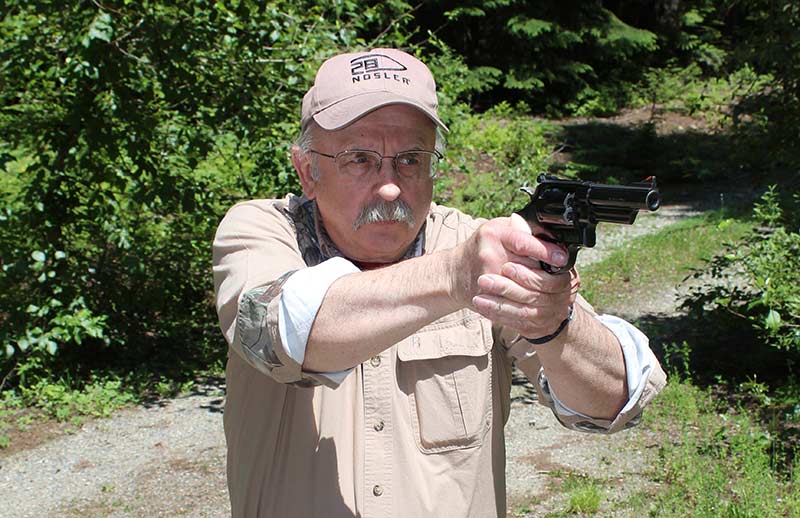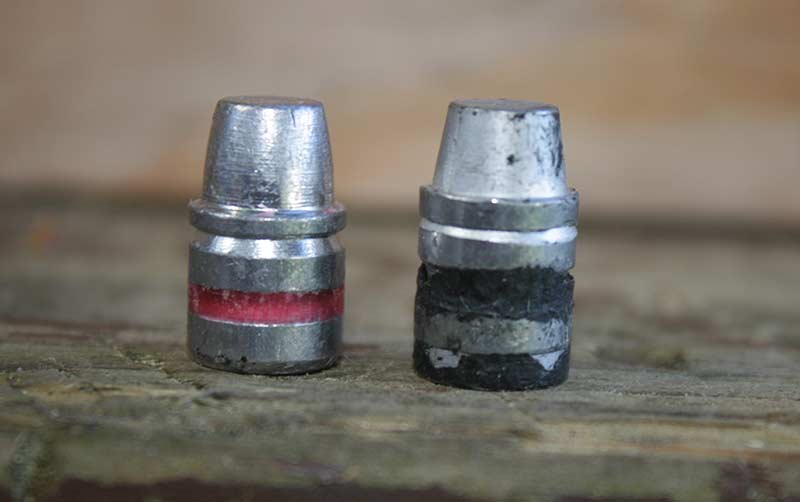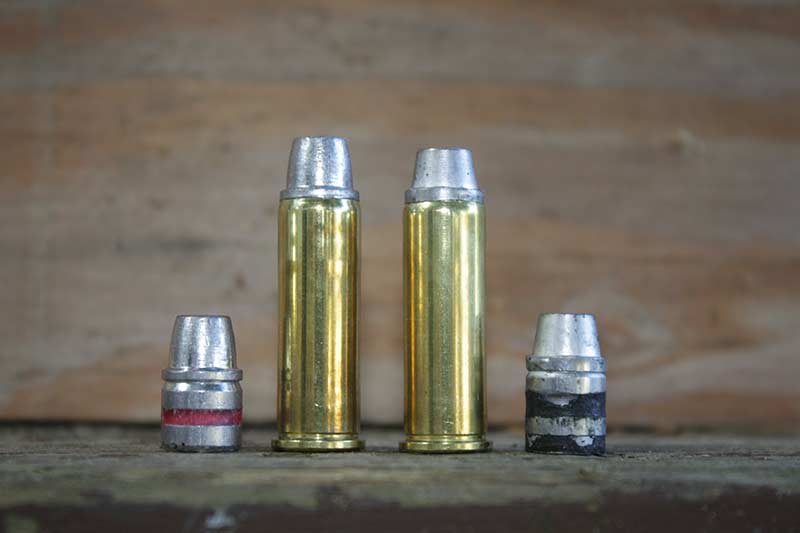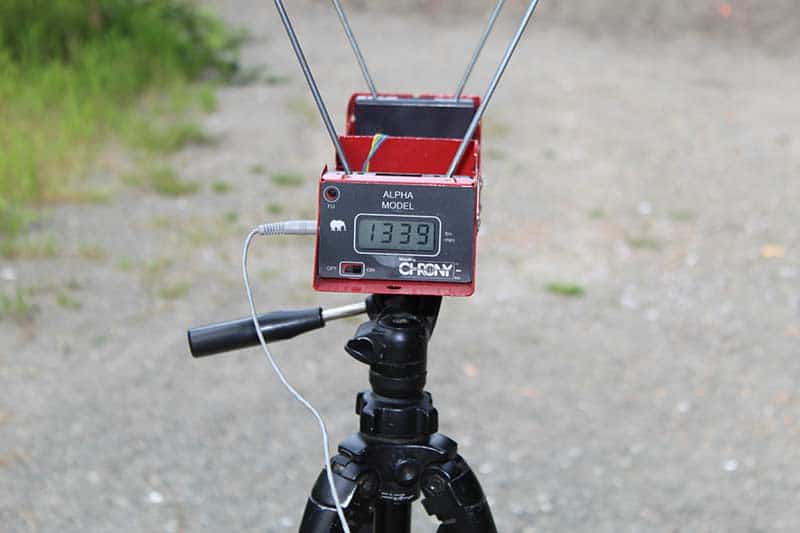Lead Reckoning
Dave Finds The Right Loads As Criminals Make The Wrong Moves
In our last installment, I was searching for a good load using a 200-grain lead SWC bullet for my .41 Magnum, a round that packs a punch but is kind to my gun hand.
I believe I’ve found it, with two different types of semi-wads, one from Stateline and the other of uncertain origin, which fell into my hands some time ago in an old Speer bullet box. It may not be the max load, but out of my 4-inch Model 57 Smith & Wesson and 4 5/8-inch Ruger Blackhawk, it is remarkably accurate.
My approach to this endeavor was deliberately done as a beginner might. Years ago, I loaded plenty of cartridges with lead bullets for my .38 Special and .357 Magnum revolvers. However, knocking together loads for my .41 Magnum is a new adventure, so I did what a first-timer might do — especially considering the relatively scant information available for assembling ammunition using 200-grain LSWC projectiles. I was not disappointed in the process.
I experimented with two propellants, Titegroup and Alliant 2400. The 200-grain Stateline over 5.5 grains of Titegroup averaged 872.6 fps, which is a bit slower than the velocity listed in Hodgdon’s Annual Manual for a cast lead flat point, but I anticipated that due to the shorter barrels on both handguns. Loads in the manual are tested in a 10.125-inch barrel. It’s a nice mild target round still capable of stopping a rabbit or coyote.
On the other hand, I worked up to 17 grains of 2400 behind both bullets, with the mysterious origin pills running a little hotter out of both guns because they seat deeper and have a slightly longer bearing surface. Out of the Ruger, the Stateline bullet averaged 1,234 fps while the other projectile clocked 1,332 fps. There were no signs of leading with either projectile.
Out of the Model 57, the Stateline load averaged 1,186 fps and the mystery bullet scooted out at an average of 1,254 fps. I should have shot at targets (that comes later) but I found both bullets flew so accurately that at 15 and even 25 yards using a two-hand hold, I could break chunks of orange clay disks someone had left on the berm at the range. If I missed, it was close enough to cover up the broken disk section or flip it.
Happily, there were no signs of high pressure, recoil was easily manageable and while this was no great discovery, I concluded that a 200-grain hard cast lead SWC going more than 1,200 fps is going to get something’s attention. Such a load can conk a black bear, mule deer buck, and even a bull elk, to say nothing of a mountain lion.
For years, my sixguns have been fed a steady diet of 210-grain JHPs from Nosler, Sierra, Hornady and Speer. All are good bullets, but now that I’ve enjoyed some homegrown ammunition launching lead bullets, I may just have to adjust my preferences.
For my next step, I’ll try some 215-grainers.
Gun Criminals Singled Out
You probably didn’t read about this anywhere else, but recently a report from the United States Sentencing Commission titled “What do Federal Firearms Offenses Really Look Like” fell into my greasy little hands and it offered some interesting information.
In a quick look, the report offered these key findings:
• Firearms offenses are among the most common crimes prosecuted and sentenced in federal court.
• The guidelines exert a strong influence on the sentences imposed in firearms cases.
• Firearms offenders sentenced under §2K2.1 (the primary firearms guideline) have criminal histories that are more extensive and more serious than other offenders.
• Firearms offenders were more than twice as likely to have a prior conviction for a violent offense compared to all other offenders (60.6% compared to 29.0%).
• The vast majority of firearms offenders (88.8%) sentenced under §2K2.1 were prohibited from possessing a firearm.
• Prohibited persons include offenders with a prior felony conviction or status in another prohibited class, such as aliens unlawfully in the United States, fugitives from justice, or persons who unlawfully use or are addicted to controlled substances.
• In addition to most §2K2.1 offenders being prohibited from possessing a firearm, firearms offenders often engaged in aggravating criminal conduct.
• In more than one-quarter of §2K2.1 cases, the firearm facilitated, or had the potential to facilitate, another felony offense (most commonly drug trafficking).
• In 11.0 percent of §2K2.1 cases, an offender or co-participant discharged a firearm. In these cases, death resulted in 4.1 percent of the cases and injury to another person in 18.3 percent of the cases.
• Firearms offenses often involved stolen firearms or particularly dangerous weapons.
• Approximately one-third (32.4%) of the offenders prohibited from possessing a firearm committed an offense involving a stolen firearm or firearm with an altered or obliterated serial number.
• Nearly one-quarter (23.6%) of the offenders prohibited from possessing a firearm committed an offense involving a prohibited weapon (such as a sawed-off shotgun or machine gun).
• The average sentence for §2K2.1 firearms offenders varied depending on the presence of aggravating factors.
• Prohibited persons who did not engage in aggravating conduct received an average sentence of 35 months. Courts imposed longer sentences on prohibited persons whose offenses involved:
• a stolen firearm or a firearm with an altered or obliterated serial number (55 months);
• a prohibited weapon (such as a sawed-off shotgun or machine gun) (58 months);
• trafficking in firearms (62 months); or
• the use of, or conspiracy to use, a firearm in connection with a crime of violence or drug trafficking crime (119 months).
So, what do we learn from this? From my perspective, the most important takeaway is to not commit crimes, especially if a gun is involved. If you ignore this advice, get used to jail food, you’ll be consuming lots of it.
For Example…
Evidently, some people didn’t read the Sentencing Commission’s report, or maybe they are part of the research.
Seattle police detectives last month pulled over a woman they were investigating for dealing fentanyl, according to KOMO News, the local ABC affiliate. The bust didn’t really go as planned because she started ramming one of the trailing vehicles, which was occupied by agents from the Department of Homeland Security.
When the lawmen finally got this woman in custody, a vehicle search yielded a Mother Lode of criminality. The list of goodies represents the ingredients necessary for a long stretch in the pen. Investigators found 1.5 pounds of methamphetamine, a half-pound of heroin, a quarter-pound of cocaine, 4.5 pounds of fentanyl powder and 6,700 fentanyl pills.
Oh, and there were also a couple of stolen handguns on the back seat. Her bad day got worse when she was booked into jail because the second her name was entered into the record, up popped a warrant from the Department of Corrections.
And This From Florida…
There are some awfully stupid criminals whose escapades probably contribute to the Sentencing Commission’s findings, and they’re not all in Seattle.
There were these three guys involved in an attempted home invasion that learned a valuable lesson about firepower. According to the Daily Caller, back on the night of July 7, they broke into a man’s home in Escambia County, pushing their way in. When the homeowner reached for his own pistol, carried in his waistband, he was shoved and the gun fell on the floor.
However, the homeowner was not without other resources. He reportedly grabbed an “AK-47-style” and opened fire. Two of the men probably broke land speed records while the third guy took one to the head, and when he tried to explain the wound to the cops, “his account of how he became wounded are inconsistent with the background information of the case.” Oh, you don’t say?
Sheriff Chip Simmons had some choice words for critics of armed self-defense.
“Those of you who may ask a question, is the homeowner going to be charged for shooting at these people? Absolutely not,” the sheriff said. “The homeowner’s protecting himself, and in Florida, in Escambia County, you can protect yourself.”
Lessons From Indiana
It has been a few weeks since a legally-armed private citizen named Elisjsha Dicken, 22, stepped forward with a GLOCK pistol and capped a killer in the food court area of the Greenwood Park Mall, preventing him from killing more than the three people he had already fatally shot.
The dead attacker, 20-year-old Jonathan Douglas Sapirman, also managed to wound two other people before he was stopped cold.
Dicken reportedly did some accurate shooting across the food court, firing ten shots from a semi-auto pistol.
Appallingly, some anti-gunners criticized Dicken for carrying a pistol into the mall, apparently in violation of Greenwood Park’s “code of conduct.” Evidently, these people would have been less offended if the mass shooter had been allowed to rack up a bigger body count. Their criticisms reinforced the notion that the gun control crowd prefers unarmed victims who cannot fight back, and make good martyrs for fundraising.
I reported on the incident at the time and did a little homework, learning in the process that Indiana has more than 1.1 million active carry permits, according to the Crime Prevention Research Center. Earlier this year, Indiana became one of 25 states with so-called “Constitutional Carry,” meaning one does not require a permit any longer to legally carry a defensive sidearm. Roughly one in 15 qualified adults is licensed to carry.
In the wake of Greenwood, I suspect even more people are now carrying in Indiana than there were a month ago.
Despite the rule against firearms in the mall, the management at Greenwood Park showed class when it posted on its website, “We grieve for the victims of yesterday’s horrific tragedy at Greenwood Park Mall. Violence has no place in this or any other community. We are grateful for the strong response of the first responders, including the heroic actions of the Good Samaritan who stopped the suspect.”
Greenwood Police Chief Jim Ison was equally eloquent when he stated this about Dicken: “His actions were nothing short of heroic. He engaged the gunman from quite a distance with a handgun. He was very proficient in that, very tactically sound. And as he moved to close in on the suspect, he was also motioning for people to exit.”






